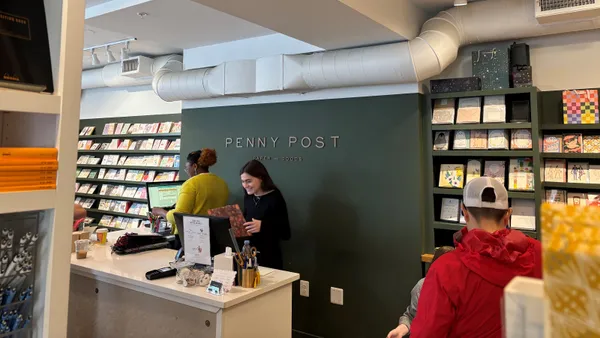Running out to grab a coffee or pick up a salad at a local place used to be a normal part of the workday.
But as employers sent their workforce home to work remotely mid-March and many schools opted for online learning in an effort to help stem the spread of the novel coronavirus, spending patterns shifted. The result was a massive disruption in how and where consumers spent their money.
"Instead of going to Starbucks and stuff to get your coffee, you're making your coffee at home. You're not having as many kids activities at night or sporting events or concerts, and you eat more dinners at home. And then on top of it, you're also just snacking more at home because you're schooling and working from home," Joe Derochowski, vice president and home industry adviser at the NPD Group, said. "If you're eating more of those meals at home, guess what? You're making more. So you just need the appliances and the houseware items to help you execute."
In the 13 weeks ending June 27, 1 million more coffee and espresso makers sold and half a million more electric grills and griddles sold compared to the same period last year, according to NPD Group data. Additionally, single-serve blending and processing products saw a 41% increase in unit sales during the period.
"We've seen it in other recessions, we also saw it after 9/11, that people kind of hunker down and leftovers become critical … making sure that I don't have any food waste," Derochowski said. "So when you think of leftover friendly dishes, there are a lot of your one-dish meals and things that can be made, whether it's [with] a multi cooker or slow cooker or casserole dish or something like this. Those have done well because people are making leftover-oriented foods."
He also noted that bakeware has seen an uptick in sales, and he expects this trend to continue heading into the holiday season. The NPD Group reported dollar sales of stand mixers grew nearly 70% year over year in the six-week period ending April 25, while hand mixer dollar sales nearly doubled. Baking not only provides a sense of comfort, Derochowski said, but it also gives people an at-home activity as they are holed up in their houses for long periods of time. This is also why, he said, sales have been up in categories like toys and electronics, including digital and video games.
The firm also reported that sales of outdoor and sports toys increased 33% in the first half of 2020 compared to the same period a year ago.
Heading into the fall, he expects sales to be driven in large part by children's schooling. "Are they going back to school? Are they going to do a hybrid approach? Are they going to be educating at home again during the fall? … It looks like the tide keeps turning towards more and more people homeschooling during the fall than would have ever been done any other time in the past."
That would indicate that sales of school supplies and electronics may see an uptick in the coming weeks and months as parents outfit children for another round of virtual learning. And with some employers not yet moving back into the office, sales of electronics and home office equipment may continue to rise as well, according to 1010data CEO Inna Kuznetsova.
"People realize that what may have seemed like a short-term change, may come without a change for a long time," she said.
How consumers are spending
A lot of the spending, unsurprisingly, shifted online over the past several months. "I think it's explained by the fact that you're spending all this time at home, you've had to change your way of working, and you may need more comfortable furniture or maybe some other arrangements in the house to free up space," Kuznetsova said.

Aside from home improvement retailers and mass merchants, which were deemed essential and therefore could remain open during lockdowns, consumers were left with few options to purchase goods in the category as nonessential retailers temporarily shuttered their doors. But according to Andy Mantis, head of data insights at 1010data, the firm is "seeing that even as states are opening up, online is holding strong."

Another thing to note, Kuznetsova said, is the growing trend of urban residents migrating to suburban or rural areas "with the possibility to work from anywhere and avoid the pains of a commute," adding that in these new homes, consumers oftentimes are forced to buy furniture to outfit those spaces.
"Home" over the last few months has transformed in many cases to include the office and school. "The definition of at home is changing a bit," Mantis said.
Interactive whiteboard sales in the past several months were up 400% year over year, while regular whiteboards were up nearly 200%, Mantis said. Web camera sales on Walmart.com also grew 1,864% in March and April 2020 compared to the same period last year, which represented the fifth fastest growing category at the mass merchant, according to 1010data. Additionally, office chairs grew 234% in March and April on Walmart.com compared to the same period last year, the firm found.
"What people do at home, the shift in emphasis is changing and their buying is going right along with it," Mantis said.
The role of the economy
Economic uncertainty is affecting spending, in part, but it really depends on a number of factors, one of which is geography. For example, Mantis said, if a local economy is fueled by an airline hub, the consumers may spend their discretionary funds in different ways than if the economy was fueled by an Amazon fulfillment center.
Helping entice consumer spending was the federal government through pandemic-related assistance. "Consumer spending on home furnishings skyrocketed after the April stimulus checks were deposited," Michael Maloof, associate director of consumer brand insights at Earnest Research, said in an email.
That's further evidenced by an 11% retail sales growth in July compared to last year, according to the Department of Commerce's figures released Friday. But not every category benefited. While furniture and home goods ticked up 1% year over year last month, electronic and appliances declined 3% and apparel plunged 20%.

With the government relief actions ended and Congress leaving for summer recess before reaching an agreement for further assistance, future spending patterns aren't certain. "Another stimulus round could give the industry its second big boost of the year," Maloof said via email.
And NPD Group's Derochowski doesn't expect spending in the home space to drop off or shift away entirely, even when the pandemic subsides. The category, particularly in the kitchen and meal prep area, has been growing for the past 16 years, he said, as consumers became more concerned about their health and wellness and began eating in more. Coming out of the crisis, "we have to wait and see, but I would suspect that we will still have close to 80% or more meals eaten at home. Because of that, it will keep these industries doing well."














